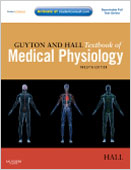The 12th edition of Guyton and Hall Textbook of Medical Physiology continues this bestselling title's long tradition as
one of the world's favorite physiology textbooks. The immense success of this book is due to its description of complex
physiologic principles in language that is easy to read and understand. Now with an improved color art program,
thorough updates reflecting today's medicine and science, and accessible online at studentconsult.com, this textbook is
an excellent source for mastering essential human physiology knowledge.
John E. Hall, PhD
I
Introduction to physiology: the cell and general physiology
1
Functional organization of the human body and control of the ''internal environment
2
The cell and its functions
3
Genetic control of protein synthesis, cell function, and cell reproduction
II
Membrane physiology, nerve, and muscle
4
The DNA code in the cell nucleus is transferred to an RNA code in the cell cytoplasm -- the process of transcription
5
Membrane potentials and action potentials
6
Contraction of skeletal muscle
7
Excitation of skeletal muscle: neuromuscular transmission and excitation-contraction coupling
8
Contraction and excitation of smooth muscle
III
The heart
9
Cardiac muscle: the heart as a pump and function of the heart muscles
10
Rhythmical excitatory and conductive system of the heart
11
The normal electrocardiogram
12
Electrocardiographic interpretation of cardica muscle and coronary blood flow abnormalities: vectrial analysis
13
Cardiac arrhythmias and their electrocardiographic interpretation
IV
The circulation
14
Overview of the circulation; medical biophysics of pressure, flow, and resistance
15
Vascular distensibility and functions of the arterial and venous systems
16
The microcirculation and lymphatic system: capillary fluid exchange, interstitial fluid, and lymph flow
17
Local and humoral control of tissue flow by the tissues
18
Nervous regulation of the circulation, and rapid control of arterial pressure
19
Role of the kidneys in long-term control of arterial pressure and in hypertension: the integrated system for aterial
pressure regulation
20
Cardiac output, venous return, and their regulation
21
Muscle blood flow and cardiac output during exercise; the coronary circulation and ischemic heart disease
22
Cardiac failure
23
Heart valves and heart sounds; dynamics of valvular and congenital heart defects
24
Circulatory shock and physiology of its treatment
V
The body fluids and kidneys
25
The body fluids compartments: extracellular and intracellular fluids; intersitial fluid and edema
26
Urine formation by the kidneys: I. Glomerular filtration, renal blood flow, and their control
27
Urine formation by the kidneys: II. Tubular reabsorption and secretion
28
Urine concentration and dilution; regulation of extracellular fluid osmolarity and sodium concentration
29
Renal regulation of potassium, calcium, phosphate, and magnesium; integration of renal mechanisms for control of blood
volume and extracellular fluid volume
30
Acid-base regulation
31
Diuretics and kidney diseases
VI
Blood cells, immunity, and blood coagulation
32
Red blood cells, anemia, and polycythemia
33
Resistance of the body to infection: I. Leukocytes, granulocytes, the monocyte-macrophage system, and inflammation
34
Resistance of the body to infection: II. Immunity and allergy
35
Blood types; transfusion; tissue and organ transplanation
36
Hemostasis and blood coagulation
VII
Respiration
37
Pulmonary ventilation
38
Pulmonary circulation, pulmonary edema, pleural fluid
39
Physical principles of gas exchange; diffusion of oxygen and carbon dioxide through the respiratory membrane
40
Transport of oxygen and carbon dioxide in blood and tissue fluids
41
Regulation of respiration
42
Respiratory insufficiency - pathophysiology, diagnosis, oxygen therapy
VIII
Aviation, space, and deep-sea diving physiology
43
Aviation, high-altitude, and space physiology
44
Physiology of deep-sea diving and other hyperbaric conditions
IV
The nervous system: A. General principles and sensory physiology
45
Organization of the nervous system, basic functions of synapses, "Transmitter sybstances"
46
Sensory receptors, neuronal circuits for processing information
47
Somatic sensations: I. General organization, the tactile and position senses
48
Somatic sensations: II. Pain, headache, and thermal sensations
X
The nervous system: B. The special senses
49
The eye: I. Optics of vision
50
The eye: II. Receptor and neural function of the retina
51
The eye: III. Central neurophysiology of vision
52
The sense of hearing
53
The chemical senses - taste and smell
XI
The nervous system: C. Motor and integrative neurophysiology
54
Motor functions of the spinal cord; the cord reflexes
55
Cortical and brain stem control of motor function
56
Contributions of the cerebellum and basal ganglia to overall motor control
57
Cerebral cortex, intellectual functions of the brain, learning and memory
58
Behavioral and motivational mechanisms of the brain - the limbic system and the hypothalamus
59
States of brain activity - sleep, brain waves, epilepsy, psychoses
60
The autonomic nervous system and the adrenal medulla
61
Cerebral blood flow, cerebrospinal fluid, and brain metabolism
XII
Gastrointestinal physiology
62
General principles of gastrointestinal function - motility, nervous control, and blood circulation
63
Propulsion and mixing of food in the alimentary canal
64
Secretory functions of the alimentary tract
65
Digestion and absoprtion in the gastroinestinal tract
66
Physiology of gastrointestinal disorders
XIII
Metabolism and temperature regulation
67
Metabolism of carbohydrates
68
Lipid metabolism
69
Protein metabolism
70
The liver
71
Dietary balances; regulation of feeding; obesity and starvation; vitamins and minerals
72
Energetics and metabolic rate


